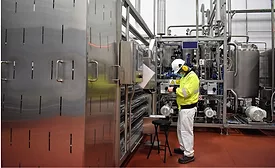Articles by Wayne Labs
Plant expansions
The sixth-generation family-owned group will add a smoked meats processing facility to its Hatfield, Pennsylvania campus
Read More
Specialized ERP software
Going paperless at the machine builder provides quick response to food companies’ demands
Building machines and lines for confectionery means a lot of one-off, unique builds, requiring instant connections to CAD and ERP
March 22, 2021
SunOpta’s Oatbase expansion right-sized for now and future needs
Built through the worst of the 2020 COVID-19 pandemic, the plant expansion came through on time, on budget and ready to boost output
March 12, 2021
Manufacturing News
Control system vulnerabilities put food & beverage at serious risk
March 8, 2021
Sustainability
Sustainability has its rewards—tangible and intangible
Suppliers and food processors work together to create projects that save energy and money—and show they’re responsible corporate citizens
March 4, 2021
Engineering R&D
Artificial intelligence simplifies industrial control for operations staff who are not data analytics experts
February 25, 2021
Cybersecurity
Remote attacks on process/automation systems can wreak havoc
Attempted takeover of a Florida fresh water utility shows the need for monitoring all users on your IT and OT networks
February 17, 2021
Decreasing Energy Usage
New technologies and concepts save energy in food and beverage plants
AI applied to energy usage/billing and integrating processes with heating and cooling systems reduce overall energy costs
February 11, 2021
Construction
A M King breaks ground on ALDI divisional headquarters and distribution center in Alabama
The new facility serves four states and expands ALDI’s presence to 38 states
February 10, 2021
FSMA Violations 2020
FDA updates data on food facility inspection violations for FY2020
FSVP development tops the list with a 51% surge over FY2019 violations
February 5, 2021
Elevate your expertise in food engineering with unparalleled insights and connections.
Get the latest industry updates tailored your way.
JOIN TODAY!Copyright ©2025. All Rights Reserved BNP Media.
Design, CMS, Hosting & Web Development :: ePublishing










